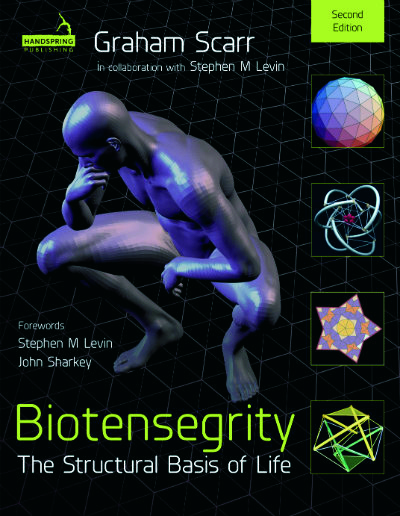Scarr, Graham
Read here about Graham Scarr, a tensegrity researcher who specializes in biotensegrity and human anatomical studies.
About Graham Scarr
Graham Scarr is a chartered biologist and retired osteopath with a particular interest in structural biology and has published several peer-reviewed articles and a book on biotensegrity, now in its second edition.
After graduating in microbiology, he spent several years developing his skills in a bacteriological research lab before undergoing a career change to study and practice as an osteopath in the UK (DO). Osteopathy recognizes that the normal relationship between structure and function is essential to the health of the human body and that this can be disturbed by trauma, posture and pathology. Manual techniques are then applied to change the structural imbalances that result from these factors and allow the body’s self-healing abilities to restore normal function.
Scarr’s interest in biotensegrity started in 2003 after reading articles by Stephen Levin, an orthopaedic surgeon who recognized the importance of biotensegrity to living organisms, and realized that it provided a much better explanation for many of the things that were observable in clinical practice. A life-long interest in natural geometry and a thorough grounding in anatomy have enabled him to work with Stephen Levin and develop new models that are progressing our understanding of the structure-function relationship in biology and the human body in particular.
Graham Scarr is a Fellow of the Royal Society of Biology (FRSB) and Fellow of the Linnean Society of London (FLS).
His website is: tensegrityinbiology.co.uk and he can be contacted through this site.
Selected Publications by Scarr
Below, a selection of publications by Scarr on tensegrity and tensegrity-related issues.
Biotensegrity, the Structural Basis of Life
Scarr’s book ‘Biotensegrity: the structural basis of life’ provides a comprehensive guide to biotensegrity, from the origin of the concept to an explanation of the basic principles, mechanics and anatomy, from molecules, cells and tissues to the complete organism. Based largely on the work of Stephen Levin, Scarr explains musculoskeletal anatomy in the light of new research, and in ways that that are of interest to every layman, robotocist, clinician and movement practitioner.
Biotensegrity book publisher's official site, http://www.handspringpublishing.com/product/biotensegrity-structural-basis-life/
Biotensegrity, What is the Big Deal (2020)
An editorial in the Journal of Bodywork and Movement Therapies highlights some of the key points of biotensegrity that are particularly relevant to anatomists, movement and manual therapy practitioners.
See: http://www.tensegrityinbiology.co.uk/thebigdeal/ Also, https://www.sciencedirect.com/science/article/pii/S136085921930230X?dgcid=author
Closed kinematic chains - the basic mechanics of tensegrity (2017)
This co-authored paper with Stephen Levin and Susan Lowell de Solórzano examines the significance of closed kinematic chains (CKCs) to biological movement and stability. Commonly used in engineering and well-described in biology over the last couple of centuries, CKCs have been largely ignored in humans yet form the basic mechanics of tensegrity. They show how a structure can move and remain completely stable throughout (dynamic stability) and lead into super-stability.
See: http://www.tensegrityinbiology.co.uk/kinematic-chains/ Also: https://www.sciencedirect.com/science/article/abs/pii/S1360859217300359
A different way of thinking about the temporo-mandibular joint (TMJ) (2017)
The problems and controversies surrounding the mechanics of the TMJ have been ongoing for the past century, and this paper now presents a biotensegrity approach that resolves them. See: Also: https://www.sciencedirect.com/science/article/abs/pii/S1214021X15300545
Model of the Cranium Vault as a Tensegrity Structure (2008)
Graham Scarr reasons that a curved strut, icosahedral tensegrity provides an elegant model of the cranial vault part of the human skull. The model helps understand how the developing cranial vault could retain its stability without relying on an expansive force from the underlying brain, a position currently unresolved. In the model, the tension of the dural membranes is deployed in such a way that prevents the bones from being compressed in the normal neurocranium, a field with great potential in better understanding some of the pathologies affecting the neonate.
Links: http://www.scribd.com/doc/33438210/Cranial-Vault-as-a-Tensegrity-Structure-by-Scarr Also, https://www.sciencedirect.com/science/article/abs/pii/S1746068908000321
Simple Geometry in Complex Organisms (2010)
Simple geometric shapes and patterns are common in living organisms, and this paper summarizes some of the basic principles of self-organization that lead to their formation.
Links: http://www.tensegrityinbiology.co.uk/publications/geometry/ Also, https://www.sciencedirect.com/science/article/abs/pii/S1360859208002039
Links and References
Scarr's website: http://www.tensegrityinbiology.co.uk/ where more information and publications can be found.
Biotensegrity book publisher's official site, http://www.handspringpublishing.com/product/biotensegrity-structural-basis-life/
